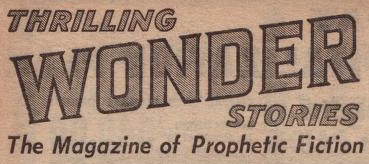The Square Pegs by Ray Bradbury appeared in the October 1948 Issue of Thrilling Wonder Stories.
The Square Pegs is an idea piece that taunts us with what it could have been but was not. It may be one of the scariest Bradbury stories I’ve read, though it’s not a horror story. It left me feeling creepy-crawly and dirty, so much so that I’m talking about it today instead of next week (I should be talking about Miracle Town, which was a cute and happy story! Next week, I promise.)
In this short story, a woman who is violently insane and believes that she is Catherine the Great is on a spaceship with her brother and two sisters. Rather than take her to an asylum, they are taking her to an asteroid. It has been discovered that the asteroids are inhabited, self-contained worlds with unique populations and cultures, each of which perfectly complements the manifestations of individuals’ unique or not-so-unique insanities. She is being taken to a world where she CAN be Catherine the Great and the inhabitants will accept her as such.
There is a tease at being more of an action-packed adventure, when the insane sister smashes the controls of the ship and forces them to crash land on an asteroid full of murderers; murderers have been dropped off on this asteroid where they can murder and kill to their hearts’ content, because the inhabitants of the world become suicidal death seekers once they enter their 20s. The crazy sister hopes that the Killers will rescue her from her captors; instead, the death seekers show up, whining and begging to be killed. The brother shoos them off, locks the crazy lady back in her cage, and they wait for rescue.
Much of this story is the brother explaining how insanity is a mismatch of individuals’ reality-paradigms with the society around them. The insane person is perfectly sane to themselves, their reality is perfectly rational, except for the fact that it doesn’t jibe with the society around them. Thus, the ideal treatment is to place those insane individuals in a place that will essentially cater to their insanities, where they can live out their fantasies happily. Thus, earth has inflicted these planetoids with their madmen and madwomen who remain on waiting lists to be admitted into their private heavens.
There was a definite feeling of menace I had when reading this story. It did not quite cross the line, but in it I could see the movement of sci-fi towards the justification of all manner of horror and self-indulgence, a cultural relativism that would allow anything to go so long as one found the perfect world to accommodate their personal malfunctions, which were certainly not crazy or wrong or evil, merely out of place. As I read this, I felt like the narrator in HP Lovecraft’s The Picture in the House, listening and growing more and more uncomfortable as I’m told “Queer haow picters kin set a body thinkin’”.
I wonder if Bradbury meant this as a dystopia.
-
Yet, we really don’t see anything like that attitude from Ray later on. An extremely nice guy from all accounts. A good friend of Leigh Brackett. He praised Edgar Rice Burroughs every chance he got. I’d be interested to see what a Bradbury scholar/critic has to say about that story.
1948? Quite early. Bradbury was obviously quite aware of the intellectual movements of his time.
Antypsychiatry didn’t get seriously going until 1960’s.
https://infogalactic.com/info/Thomas_Szasz
There were two separate fractions in it – libertarian like Szasz, and Communists, like in Italy, where the Communist Party pushed through quite far going reforms.
https://infogalactic.com/info/Deinstitutionalisation
https://infogalactic.com/info/Basaglia_Law
There is also a similar short story by Vance: The Men Return. But it is not so sympathetic towards the mad reality shaped by madmen.
This story is now available on Project Gutenberg.
It was included in a second collection of 100 stories chosen by Bradbury.
I don´t really understand what point he was trying to make.